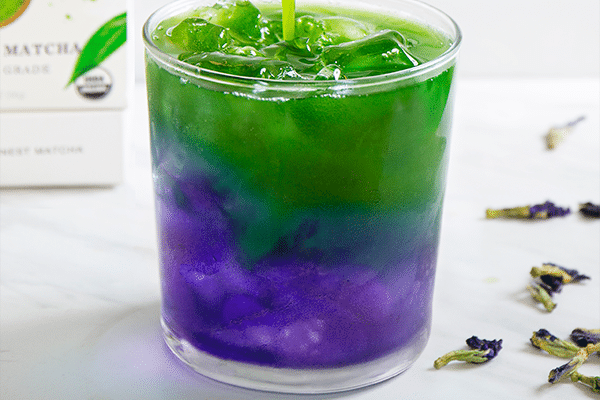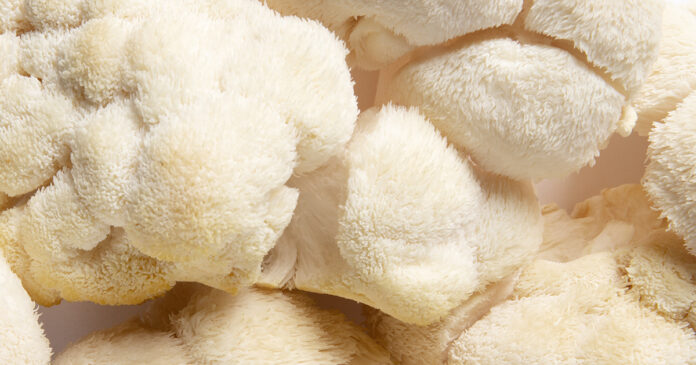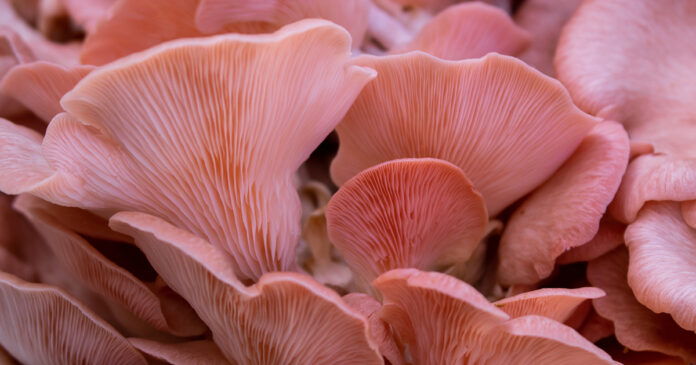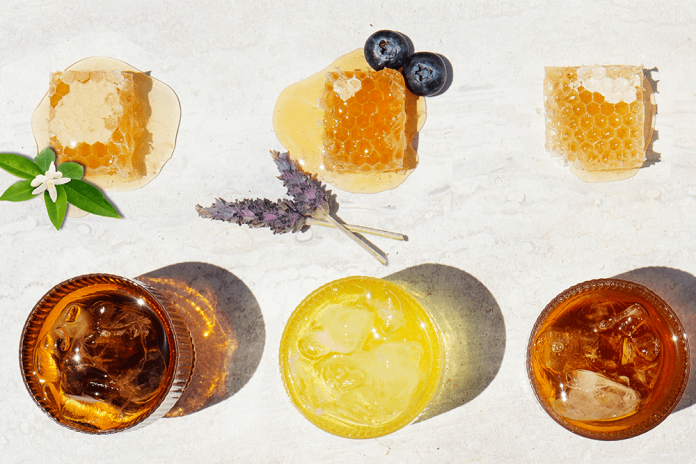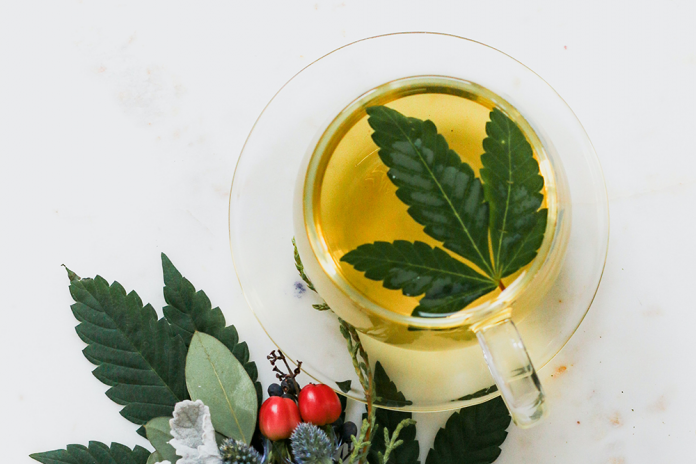If you’re looking to mix up your tea-drinking routine, look no further than butterfly pea flower tea. Butterfly pea flower, scientifically known as the clitoria ternatea plant, grows primarily in Southeast Asia. It’s a popular beverage in Malaysia, Thailand and Vietnam. [1]
It’s characterized by its vibrant blue leaves and purple color in your cup! That’s why we sometimes refer to this infusion as “blue tea.”
Even before enjoying it as a drink, folks used butterfly pea flower as a dye and natural food coloring for rice dishes and desserts. When brewed, the rich color seeps through the hot water, making an infusion almost too pretty to drink.
But what’s really garnering the attention of tea drinkers is a bit of chemistry.
Why does butterfly pea tea change color?
Do you remember testing the pH levels of various solutions with litmus strips in high school? Anything that deviated from neutral would cause the strip to change color.
The compounds in blue tea undergo a similar reaction when acidity is introduced. Squeeze in a little lemon juice, and the deep blue hue quickly transforms to purple. As you add more acidity, the liquid changes color to magenta and pink.
If you ever see a color-changing cocktail on the menu of your local bar, it’s likely your mixologist is using butterfly pea flower leaves to perform his mesmerizing magic trick.
The chief molecules involved in this reaction belong to a family of phenolic compounds called anthocyanins — phytochemicals responsible for butterfly pea flower’s blue color and a host of health benefits.
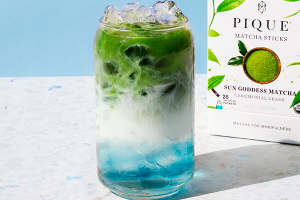
What is butterfly pea flower tea good for?
Anthocyanins have antioxidant properties known to support overall health. Like all antioxidants, anthocyanins help neutralize free radicals that would otherwise seek to cause cell damage in your body – leading to less-than-optimal health. [2][3][4]
What are the health benefits of anthocyanins?
Studies have shown that anthocyanins can support healthy metabolism of fat, which can help maintain healthy cholesterol levels, healthy blood sugar regulation, and a healthy body weight.
Butterfly pea flower also contains the catechin EGCG — the predominant antioxidant in green tea — which has been shown to have similar effects on fat metabolism. Some analyses have found that blue tea actually contains higher EGCG content than any other herbal tea.
Other research shows that people who regularly consume anthocyanins experience supported memory retention and cognitive function. [5][6] More studies are needed, however, to confirm the doses at which these health benefits are meaningful for most people.
What health benefits am I likely to notice?
The study of specific polyphenols has just picked up over the past few years. While you’ll see information claiming that anthocyanin (or any antioxidant for that matter) can help you lose weight, prevent illness, etc…, there are no magic pills.
The truth is that these compounds are just one potential part of a many-pronged approach to health, including a balanced diet, plenty of sleep and exercise.
One study, for example, gave a group of 57 men either a fruit juice drink rich in anthocyanins, or one without this particular antioxidant. At the end of 8 weeks, researchers found that both groups saw weight loss, reduced LDL cholesterol and fewer signs of inflammation. But it wasn’t clear whether they had anthocyanin to thank, or the high Vitamin C content of both drinks. [7]
Despite the confusion, the takeaway is the same: incorporating more antioxidant rich plant foods into your diet can’t hurt!
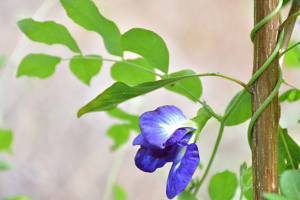
What does butterfly pea flower taste like?
The bright blue color of butterfly pea tea might fool you into expecting a fruity flavor, but the taste is more like a light version of green tea — slightly earthy, grassy and astringent. Lemon juice and honey are commonly added to brighten and sweeten the taste. Other traditional additions include ginger, mint, lemongrass and cinnamon.
Because it is naturally caffeine-free, butterfly pea tea is traditionally consumed hot as an after-dinner, pre-bedtime drink, but there are plenty of ways to get creative with this versatile flower to highlight its fun colors. Here are three blue tea recipes for hot, iced, and latte versions that range from simple to show-off.
Basic Blue Tea
- Bring a pot of water to boil, then remove from heat and give it a minute to cool slightly.
- Pour the water over 1-2 teaspoons of dried butterfly pea leaves and let steep for 5 minutes
- Strain out the leaves, and give it a taste so you don’t miss out on true blue tea flavor!
- Add a squeeze of lemon juice and watch the color transform.
- Optional: Drizzle in a teaspoon or two of honey if you prefer a little sweetness.
Fizzy Iced Blue Tea Lemonade
- Start by brewing a pot of blue tea, sticking to the ratio of 1-2 teaspoons of dried leaves per 8 ounces of water. Once strained, let the tea cool.
- Make a sugar syrup by mixing 1 cup of sugar with 1 cup of water and heating it to a simmer, mixing until all of the sugar is dissolved. You could also use honey or agave nectar in place of syrup. Or skip the sugar altogether! Just be prepared for tart, rather than sweet lemonade.
- Fill a tall glass with ice cubes. Drizzle in 2 tablespoons of your sweetener, if using. Pour over your tea until the glass is about ¾ full.
- Squeeze in up to a quarter cup of lemon juice. (You may want to scale this back if you are forgoing sweetener).
- Give it a good stir and top with seltzer water.
Hot Blue Tea Latte
- Pour about a cup of milk into a saucepan. A thicker consistency is better, so opt for whole milk. If you’re vegan or dairy just isn’t part of your diet, go with a more substantial oat, soy or cashew milk over an almond or rice variety.
- Add your dried butterfly pea flowers to the milk, along with any spices you like. Fresh cinnamon, ginger and cardamom will make for a cozy drink.
- Slowly warm up the mixture, stirring regularly. Simmer gently for 10-15 minutes.
- Strain out your leaves and spices.
- A frother will come in handy here, but a handheld blender with a whisk attachment will also work well. Whip vigorously until the milky tea thickens a little and froths up.
- Once you reach your desired consistency, pour into your favorite mug and enjoy!
Where can I find butterfly pea flower tea?
Until recently, tea drinkers outside of Southeast Asia could only find butterfly pea flower online. Now that blue tea is gaining popularity around the globe, though, it’s becoming easier to find on standard supermarket shelves in the United States, usually in bagged form. Bagged blue tea leaves may be packaged with other leaves including hibiscus, rose or lemongrass. If you prefer to avoid tea bags, pecialty tea shops are more likely to have the whole, dried flowers on their own.
The Last Drop
Butterfly pea flower, or blue tea, is best known for its color-changing properties, but also packs a healthy dose of antioxidants, without any caffeine. It’s best enjoyed hot with a squeeze of lemon juice or lime juice and a drizzle of honey as an end-of-day beverage. You may have to do a little searching to find it on store shelves, but this fun color-changing tea is definitely worth the effort.
